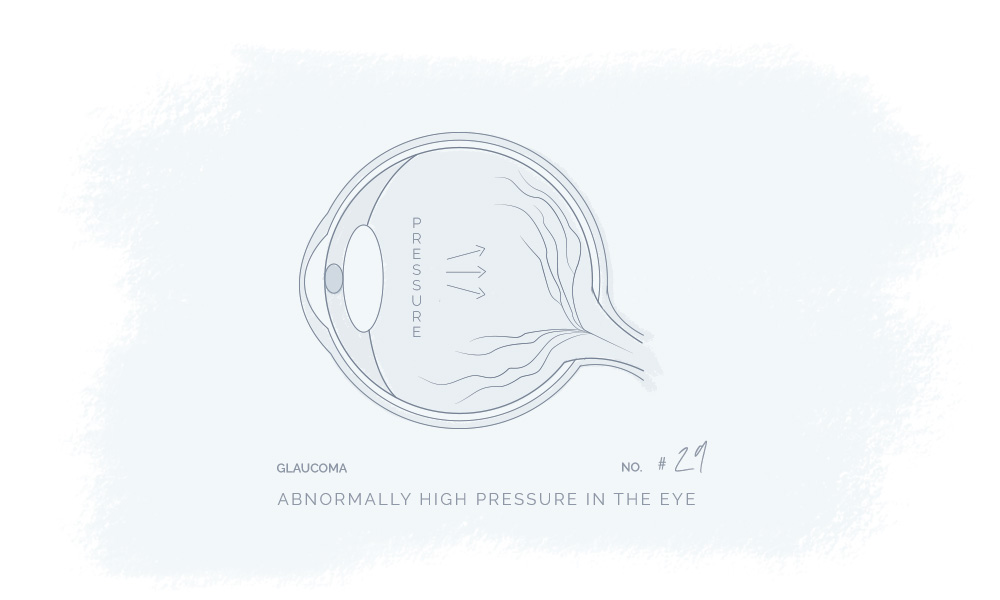Glaucoma
Category
Eye/ear diseases & symptoms
REVIEWED BY
Our Biomedical Scientist
Reviewed based on
Literature Discussion & Clinical Trials
Last update
September 2020

What is Glaucoma
Glaucoma is a group of eye conditions that lead to abnormally high pressure in the eye, which can cause optic nerve damage. Glaucoma can lead to irreversible blindness, but if the disease is discovered before an advanced state, vision loss can be slowed down or prevented.1
Symptoms
The signs and symptoms of glaucoma depend on the type and stage of the disease.1
Open-angle glaucoma
- Blind spots in the central vision or in the side
- Tunnel vision
Acute angle-closure glaucoma
- Severe headache
- Nausea and purging
- Eye pain
- Eye redness
- Halos around lights
Cause
Damage to the optic nerve causes glaucoma. As this nerve exacerbates, it results in the development of blind spots in the visual field. Increased pressure in the eye is caused by a buildup of fluid either due to overproduction or the drainage system working improperly (i.e. the fluid is not allowed to flow out in a normal manner.1
The connection between Cannabinoids & Glaucoma
Studies find that CBD and THC may have great therapeutic potential and may be used to help treat Glaucoma. CBD and THC are well-known cannabinoids, however, they do not have the same psychoactive effects. THC is psychoactive while CBD does not possess psychoactive effects. According to WHO guidelines, the cannabidiol CBD is generally well tolerated with a good safety profile.
It was shown that the cannabinoids THC, CBG, and CBN has the potential to decrease intraocular pressure in patients suffering from glaucoma. THC was found to have the best potential in the treatment of glaucoma.2
The literature discussion is an overview of the published results from scientific studies investigating if and how cannabinoids can be beneficial in the treatment of Glaucoma. The overview will be updated regularly to ensure the newest and most accurate information.
Cannabinoid receptors may play an important role in glaucoma treatment
In mice, 2-oleoylglycerol (2OG) was shown to interact with GPR119 and lower intraocular pressure giving new potential targets in glaucoma treatment.3
Similarly, increasing 2AG through suppression of MAGL also lowered intraocular pressure but in a CB1 -dependent way.4,5
In mice, intraocular pressure was shown to be lowered by 30% through stimulating CB1.6
Clinical trials are research studies that examine new treatments and evaluate their effects on human health outcomes.
THC linked to a reduction in intraocular pressure
A randomized, double-masked, placebo-controlled, 4-way crossover study included six patients to evaluate the effect of oromucosal administration of cannabinoids on intraocular pressure. It was found that intraocular pressure was significantly reduced by THC after two hours, while 20 mg CBD did not produce significant effects and 40mg CBD enhanced intraocular pressure.7
In eight healthy volunteers, intraocular pressure was reduced by THC (7.5 mg). Retinal blood flow was also shown to be improved by the same cannabinoid.8
In eighteen patients, intraocular pressure was reduced when smoking cannabis.9
- https://www.mayoclinic.org/diseases-conditions/glaucoma/symptoms-causes/syc-20372839
- https://ghmedical.com/endocannabinoid-system/diseases/glaucoma-0
literature - Miller, S., Et al., (2017). ” A GPR119 Signaling System in the Murine Eye Regulates Intraocular Pressure in a Sex-Dependent Manner. Ophthalmol. Vis. Sci. 58, 2930–2938”. https://iovs.arvojournals.org/article.aspx?articleid=2631571
- Alapafuja, S.O., Et al., (2018a). ” Synthesis and evaluation of potent and selective MGL inhibitors as a glaucoma treatment. Med. Chem”. https://pubmed.ncbi.nlm.nih.gov/30446439/
- Miller, S., Et al., (2016). “Harnessing the endocannabinoid2-Arachidonoylglycerol to Lower Intraocular Pressure in a Murine Model. Ophthalmol. Vis. Sci. 57, 3287–3296”. https://pubmed.ncbi.nlm.nih.gov/27333182/
- Miller, S., Et al., (2018b). ”Controlled-Deactivation CB1Receptor Ligands as a Novel Strategy to Lower Intraocular Pressure. Pharm. Basel Switz. 11”. https://pubmed.ncbi.nlm.nih.gov/29786643/
- Tomida, I., Et al., (2006). ”Effect of sublingual application of cannabinoids on intraocular pressure: a pilot study. J. Glaucoma 15, 349–353”. https://pubmed.ncbi.nlm.nih.gov/16988594/
- Plange, N., et al., (2007). ”Dronabinol and retinal hemodynamics in humans. J. Ophthalmol. 143, 173–174”. https://pubmed.ncbi.nlm.nih.gov/17188063/
- Merritt, J.C., Et al., (1980). ”Effect of marihuana on intraocular and blood pressure in glaucoma. Ophthalmology 87, 222–228”. https://pubmed.ncbi.nlm.nih.gov/7053160/
CANNABINOIDS & RECEPTORS
Below you find the plant cannabinoids, cannabinoid receptors, and endocannabinoids that are associated with the potential therapy.
- CBG
- CBN
- CBD
- THC
- Δ8THC
- 11-OH-Δ9-THC
- CB1
- GPR18
- GPR119
- 2AG
- 2OG
If you have any further information relevant to the connection between Glaucoma and cannabinoids or find any of the information inaccurate, outdated or incomplete please contact us here.

